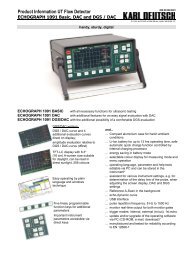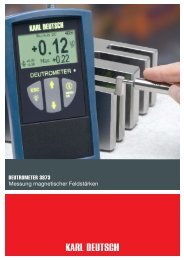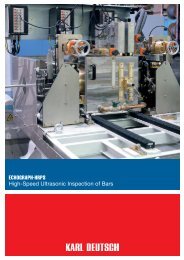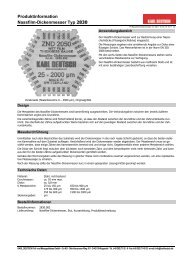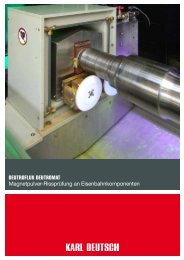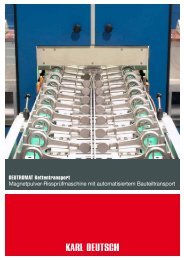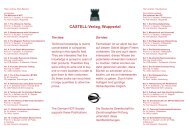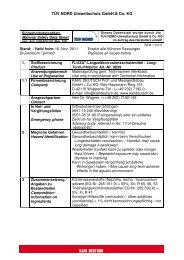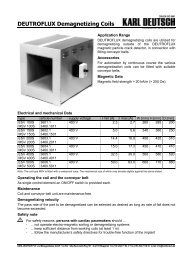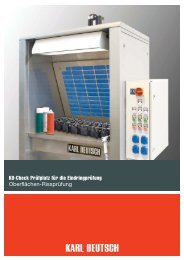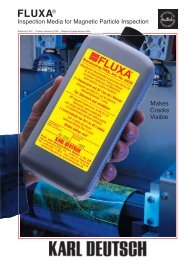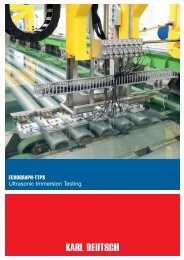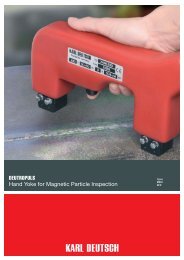here - Karl Deutsch
here - Karl Deutsch
here - Karl Deutsch
- TAGS
- karl
- www.karldeutsch.de
You also want an ePaper? Increase the reach of your titles
YUMPU automatically turns print PDFs into web optimized ePapers that Google loves.
ECHOGRAPH Systems<br />
Automated Ultrasonic Inspection<br />
Material Testing for Quality Control
ECHOGRAPH Ultrasonic Testing Systems<br />
Company Portrait<br />
KARL DEUTSCH has developed ultrasonic testing equipment<br />
since 1951 and has shipped the fi rst automated inspection<br />
system in 1965. Many improvements for the<br />
ECHOGRAPH electronics, the robust testing mechanics<br />
and the ultrasonic probes have led to our current state-ofthe-art.<br />
The company is located in Wuppertal, a city near Duesseldorf<br />
and Cologne, Germany. At the moment 130 highly<br />
motivated employees work for the company. Additional 20<br />
employees in international sales offi ces support our customers<br />
worldwide.<br />
KARL DEUTSCH offers a large product range: Portable<br />
testing instruments such as ultrasonic fl aw detectors, ultrasonic<br />
sensors for manual and automated applications,<br />
magnetic particle testing systems, crack detection liquids<br />
(magnetic particles and dye penetrants) and systems for<br />
dye penetrant inspection. Furthermore the portfolio of<br />
KARL DEUTSCH contains phased array testing systems<br />
Works 2 was built to cater to the systems business. The fi rst<br />
workshop hall was built in 1978 and extended in 2004 and 2006.<br />
In 2008, a segment of Wuppertal’s historic skytrain (inaugurated<br />
in 1900) was purchased and newly mounted as an industrial<br />
monument.<br />
View into the systems workshop w<strong>here</strong> a large immersion test<br />
tank is about to be assembled. The mechanical workshop<br />
allows the fabrication of the key components.<br />
2<br />
Works 1 (erected in 1967, extended in 1972) is the headquarter<br />
w<strong>here</strong> the administration, the applications lab and<br />
electronics R&D are located. Portable test instruments,<br />
sensors and crack detection liquids are produced <strong>here</strong>.<br />
due to a partial ownership of the French company M2M<br />
Phased Array Technologies and a joint product development<br />
with the BAM in Berlin. A strict quality management<br />
system according to DIN EN ISO 9001 is maintained.<br />
Staff in the systems workshop of works 2: KARL DEUTSCH provides<br />
testing systems and machines from a single source with an<br />
in-house construction department, a mechanical workshop and<br />
a department for producing and programming the Siemens-PLC.<br />
In total, 1500 m² are available for the systems assembly.<br />
Large testing machines often require complex logistics during<br />
assembly. The total workshop area of 1500 m² and two cranes<br />
permit also the assembly of large-scale systems.
ECHOGRAPH System Types KNPS STPS HRPS<br />
Ultrasonic Inspection of Billets and Bars<br />
ECHOGRAPH-KNPS: Continuously cast billets are regularly<br />
tested with ultrasound during the production process. The testing<br />
speed of round or quadratic billets with typical dimensions<br />
between 50 and 180 mm is 1 m/s. In this process stage especially<br />
the quadratic billets exhibit considerable tolerances (convex<br />
or concave surfaces,<br />
different edge radii and<br />
twisted profiles), which<br />
demand a flexible guidance<br />
of the probe holders<br />
on the billet surfaces. By<br />
means of spring systems<br />
the sensors can be guid-<br />
Testing of quadratic billets with ed along the profile within<br />
28 probes in 4 probe holders a working range of several<br />
centimetres. While<br />
formerly block cast billets were tested with only 2 probes for<br />
core defects, nowadays an inspection with the highest possible<br />
ECHOGRAPH-STPS: In a further process stage the billets are<br />
rolled to bars, which still have black surfaces. The straightness<br />
tolerances in this<br />
stage require a guiding<br />
of the probes on the<br />
surface within a range<br />
of several millimetres.<br />
Coupling is carried<br />
out with water jets<br />
(squirters). The typi-<br />
Testing of (e.g. black) bars with cal diameters for this<br />
9 probes in 3 probe holders<br />
inspection task are 10<br />
to 130 mm. The higher<br />
the number of probes, the larger is the covered cross section.<br />
This type of system can be equipped with 3 to 15 sensors.<br />
The mechanical design enables a very easy and quick<br />
ECHOGRAPH-HRPS: Bars with bright (machined) surfaces are<br />
often used as raw material in the automotive and aerospace<br />
industry. The cross sections<br />
must be completely<br />
covered. For this purpose<br />
an immersion tank setup<br />
is available with typi-<br />
Testing of (e.g. bright) bars with 21<br />
cally 21 sensors (16 angle<br />
beam probes and<br />
5 straight beam probes).<br />
The inspection speed is in<br />
probes in immersion technique<br />
the range between 1 and<br />
2 m/s. The good surface<br />
condition allows accordingly higher inspection sensitivities between<br />
0.7 and 1.5 mm FBH. Currently, this testing concept is<br />
suitable for diameters from 10 to 90 mm.<br />
3<br />
coverage of the cross section area is required. T<strong>here</strong>fore today,<br />
typically 28 probes are applied. The typical test sensitivity ranges<br />
from 1.5 to 5 mm FBH.<br />
diameter adjustment. The typical testing sensitivities are in<br />
the range between 1 and 2 mm FBH.
ECHOGRAPH System Types RPTS ALPT TTPS<br />
Ultrasonic Inspection of Round Billets<br />
ECHOGRAPH-RPTS: Larger bars or billets with round cross sections<br />
are inspected with rotation of the billet and linear feeding<br />
of the ultrasonic probes.<br />
Several probes are used<br />
to increase the test speed.<br />
For good surface quality,<br />
clean-cut billet ends and<br />
reasonable straightness,<br />
all probes can be mounted<br />
into the same probe<br />
Inspection of billets with rotation of holder. The probe holder is<br />
the billet and linear feeding of probes fitted to a carriage which<br />
travels along a testing<br />
portal. The typical billet diameters for such test portals starts at<br />
100 mm, i.e. at a range, w<strong>here</strong> systems with linear throughput<br />
would require an extremely high number of probes to fully cover<br />
the cross section. The testing sensitivity (from 0.8 mm FBH) depends<br />
on diameter, material structure and surface condition.<br />
ECHOGRAPH-ALPT: For cast aluminium billets with<br />
rough surfaces the probes are mounted into several probe<br />
holders which are<br />
evenly distributed<br />
along the billet. Otherwise,<br />
the testing<br />
concept is similar to<br />
the ECHOGRAPH-<br />
Straight beam and angle beam tes-<br />
RPTS system. Straight<br />
beam probes are used<br />
for the core defect<br />
ting for round billets<br />
detection. In some<br />
cases additional angle<br />
beam probes are provided to test the near-surface zones.<br />
The testing system in the right picture contains 10 straight<br />
beam probes for core defect detection in accordance with<br />
ECHOGRAPH-TTPS: The highest testing sensitivity can be<br />
achieved with an immersion tank testing system because of the<br />
best possible coupling<br />
Immersion testing with 3 straight beam<br />
conditions. This test tank<br />
is designed for aluminium<br />
billets in the aerospace<br />
industry. The billet diameters<br />
range from 172 to<br />
620 mm and the lengths<br />
between 0.3 and 2 m. The<br />
test sensitivity is 0.8 mm<br />
probes and 6 angle beam probes<br />
FBH for the straight beam<br />
probes. Additional angle<br />
beam probes detect surface flaws. The sensitivity adjustment<br />
and TCG-curve recording are carried out fully automatically. The<br />
test results are given in C-scan format.<br />
4<br />
ASTM B 594-90, i.e. 1.98 mm FBH. In addition, 6 angle beam<br />
probes detect surface defects in the billet ends.
ECHOGRAPH System Types HRPR RPSR RPTR<br />
Ultrasonic Inspection of Seamless Tubes<br />
ECHOGRAPH-HRPR: The criterion for the selection of the appropriate<br />
testing system is the diameter of the tube. The insonification<br />
directions depend on<br />
the test requirements. The<br />
most important inspec-<br />
High speed tube testing with statiotion<br />
task is the detection<br />
of longitudinal defects with<br />
an angular insonification in<br />
both circumferential directions.<br />
The tube is surrounded<br />
by 2 probe rings with<br />
nary probes (40 probes in 3 rings) overlapping sound beams.<br />
A wall thickness measurement<br />
is often carried out with 8 straight beam probes. The detection<br />
of transverse defects requires additional probe rings. Tubes with<br />
diameters between 10 and 180 mm can be inspected with the system<br />
ECHOGRAPH-HRPR. The great advantage of this system is<br />
the high testing speed of up to 2 m/s. The tubes are linearly moved<br />
ECHOGRAPH-RPSR: Tubes with larger diameters (e.g.<br />
up to 610 mm) can be tested in partial immersion with this<br />
system. The probes are positioned below the tube in waterfilled<br />
chambers and<br />
remain in their position,<br />
while the tube is<br />
moved helically over<br />
the test chambers.<br />
Helical tube testing in partial immer-<br />
This method also permits<br />
a good coupling<br />
of larger probes (multichannel<br />
probe battersion<br />
and three test chambers ies or phased arrays).<br />
A tube conveyor must<br />
be provided, w<strong>here</strong> the linear and rotational tube movement<br />
must work without any slip. Typically, three test chambers are<br />
ECHOGRAPH-RPTR: A third possible testing concept is a portal<br />
system. This system is best suited for an offline inspection. A conveyor<br />
system charges the<br />
tubes. After the tube is fed<br />
into the portal, it becomes<br />
rotated by means of a<br />
roller block. The number<br />
of probes depends on the<br />
required throughput. The<br />
probe holders are posi-<br />
Tube testing with testing portal and tioned in the 12 o’clock<br />
multi-probe holders (cluster)<br />
position and are moved<br />
linearly along the tube.<br />
Thus the tube is scanned helically. Typical diameters range from<br />
150 to 750 mm. Again, five incidence directions are employed to<br />
cover all relevant defects and to measure the wall thickness.<br />
5<br />
without any mechanical rotation of tubes or probes. The detectability<br />
of short defects and little mechanical wear is a special feature of<br />
systems with stationary probes.<br />
provided for: a) longitudinal defects, b) transverse or oblique<br />
defects and c) wall thickness measurement and laminations.
ECHOGRAPH System Types BAPS SNHF RPTR<br />
Ultrasonic Inspection of Electric Resistance Welded (ERW) Pipes<br />
ECHOGRAPH-BAPS: The production of ERW-pipes includes<br />
several steps of NDT. The usage of NDT has two major goals:<br />
Early information about<br />
the welding procedure<br />
Strip testing with probes for both<br />
as a feedback for the<br />
production line and secondly,<br />
the fi nal inspection<br />
of the fi nished pipe. Several<br />
ultrasonic systems are<br />
typically encountered during<br />
the production proc-<br />
strip edges and for the strip middle ess. A strip tester is often<br />
used for testing the pipe<br />
body before welding. The strip edges are tested with separate<br />
probe holders and 100% ultrasonic coverage. Linear or oscillating<br />
test traces for the strip middle probes are possible. This example<br />
shows a testing system with 16 probe holders. Dual-element<br />
probes must be used due to the low strip thickness. Each probe<br />
ECHOGRAPH-SNHFS: Directly after welding, a fi rst ultrasonic<br />
weld inspection is carried out with an online weld testing<br />
system. Longitudinal defects are detected with 4 probes<br />
(2 for external defects<br />
and 2 for internal defects).<br />
Optional lamination<br />
probes inspect<br />
the heat-affected<br />
zone. An oscillating<br />
deburring check using<br />
1 straight beam probe<br />
Weld testing with A) longitudinal, is sometimes added<br />
B) transverse and C) lamination probes<br />
to verify the proper<br />
descarfi ng of the internal<br />
pipe wall. Typical testing speeds range between 10<br />
and 35 m/min and correspond to the welding speed. Water<br />
ECHOGRAPH-SNHFT: After pipe cutting and the hydrostatic test,<br />
the fi nal weld inspection can be carried out with a testing portal<br />
w<strong>here</strong> the weld is turned<br />
into the 12 o‘clock position.<br />
A portal proves advantageous<br />
because the weld<br />
is inspected without pipe<br />
movement, thus avoiding<br />
vibrations which could<br />
degrade the test results.<br />
Almost similar probe confi<br />
gurations are used for the offl ine weld test. Optional transverse<br />
probes can be provided. Water jet coupling for the angle beam<br />
probes allows high testing speeds (typically up to 1...1.5 m/s) and<br />
t<strong>here</strong>fore an overall high throughput rate. If no strip testing system<br />
is employed, the pipe body test can be performed in a separate<br />
6<br />
uses 1 transmitter and can contain 1 to 3 receiver elements. All<br />
probes are mounted to a testing bridge and can be moved offl ine<br />
above a test plate for dynamic and convenient calibration.<br />
jet coupling eases the inspection of the hot pipe directly<br />
after welding (see picture).<br />
testing system (e.g. ECHOGRAPH-RPTR) or by providing a second<br />
full-body probe carriage (small picture, left side).
ECHOGRAPH System Types BAPS SNUS SNUL<br />
Ultrasonic Inspection of Submerged Arc Welded (SAW) Pipes<br />
ECHOGRAPH-BAPS: Helically welded as well as longitudinally<br />
welded pipes have to be inspected with ultrasound if they are<br />
intended to be used for the transport of oil and gas. Helically<br />
submerged arc welded<br />
pipes (HSAW) are manufactured<br />
in a continuous<br />
process from a virtually<br />
“endless” strip. Consecutive<br />
strips are connected<br />
by means of a butt weld.<br />
The ECHOGRAPH-BAPS<br />
Strip and plate testing confi guration strip testing system must<br />
with 100% ultrasonic coverage be mounted on a rotatable<br />
carrier, which is<br />
placed directly before the welding machine. The rotation angle<br />
corresponds to the pipe weld angle. Recent requirements suggest<br />
solutions with high ultrasonic coverage. An overlapping<br />
probe arrangement with 100% ultrasonic coverage is shown in<br />
ECHOGRAPH-SNUS: The wall thicknesses for HSAW-pipes<br />
are limited to max. 20 or 25 mm because of the forming process.<br />
T<strong>here</strong>fore, 4 sensors<br />
are typically suffi<br />
cient for the detection<br />
of longitudinal defects.<br />
Also 2 (e.g. on-bead)<br />
probes are provided to<br />
detect transverse defects.<br />
These 6 probes<br />
Angle beam probes for the inspec- (see small fi gure) are<br />
tion of HSAW-pipe welds<br />
applied during the fi rst<br />
online weld test (e.g.<br />
on endless pipe directly behind the welding machine) as well<br />
as in the fi nal offl ine system (for the pipes which are already<br />
cut to their fi nal length). The detection of delaminations in the<br />
ECHOGRAPH-SNUL: Larger wall thicknesses can be produced<br />
in case of longitudinally submerged arc welded pipes (LSAW).<br />
This often requires further<br />
tandem probes in order to<br />
detect longitudinal lacks<br />
of fusion in mid-seam reliably.<br />
Transverse probes<br />
can be realised on-bead<br />
to avoid the cumbersome<br />
calibration of the conventional<br />
X-setup. Lamination probes cover the heat-affected zone.<br />
Two testing concepts are found. Most common is a machine<br />
stand and the inspection of a linearly moving pipe (small picture).<br />
Higher throughputs and superior test results can be obtained<br />
by means of a testing portal with unmoved pipe during<br />
test (large picture).<br />
7<br />
both pictures. The heavy plates for SAW-pipes with longitudinal<br />
welds are typically tested in the plate mill with up to 400 testing<br />
channels and up to 100 probes.<br />
heat-affected zone and in the pipe ends are additional inspection<br />
tasks for the offl ine test.
ECHOGRAPH System Types STFL SCHN TTPS<br />
Ultrasonic Inspection of Pressure Cylinders, Rails and other Components<br />
ECHOGRAPH-STFL: This testing system is designed<br />
for rough environmental conditions and high throughput.<br />
The system is t<strong>here</strong>fore ideally suitable for the manufacturer<br />
of gas cylinders. The cylindrical part of the cylinder<br />
is tested in a helical<br />
testing trace.<br />
Defects of all relevant<br />
orientations<br />
are detected in one<br />
test run. While the<br />
cylinder is rotating,<br />
the probes are linearly<br />
guided along the longitudinal axis of the cylinder.<br />
2 probe holders and 10 probes are typically employed<br />
(test principle similar to ECHOGRAPH-RPTR).<br />
ECHOGRAPH-TTPS: Bearing rings can be inspected<br />
in an immersion tank testing system. The bearings are<br />
designated for highspeed<br />
trains and<br />
t<strong>here</strong>fore the testing<br />
sensitivity complies<br />
with DIN EN 12080,<br />
thus enforcing a<br />
0.5 mm flat bottom<br />
hole as calibration<br />
reflector which imposes<br />
the highest<br />
ECHOGRAPH 1155 Electronics: The evaluation of the ultrasonic signals<br />
is carried out with the digital ECHOGRAPH 1155. This multichannel<br />
ultrasonic electronics is specially designed for automated<br />
ultrasonic testing. Four flaw gates, two amplitude thresholds, a programmable<br />
TCG (time-corrected gain, sometimes also called DAC for<br />
distance amplitude correction) and multiple evaluation parameters are<br />
standard. Remote diagnosis and service can be provided via TCP/IP<br />
directly from KARL DEUTSCH in Germany. Data exchange with a host<br />
computer or an SQL data base is possible as an option.<br />
KARL DEUTSCH Pruef- und Messgeraetebau GmbH + Co KG<br />
Otto-Hausmann-Ring 101 · 42115 Wuppertal · Germany<br />
Phone (+49 -202) 7192-0 · Fax (+49 -202) 7149 32<br />
info@karldeutsch.de · www.karldeutsch.de<br />
ECHOGRAPH-SCHN: The standard configuration of an<br />
ultrasonic rail testing system contains 16 probes, w<strong>here</strong><br />
7 probes are used for the inspection of the rail head,<br />
6 probes for the rail<br />
flange and three<br />
probes for the rail<br />
foot. Straight beam<br />
probes are usually<br />
chosen. Water jet<br />
coupling provides<br />
good access to<br />
the complex and strongly curved rail profile. The probe<br />
holders can be adjusted by hand or fully automatically.<br />
The testing speed typically amounts to 1 m/s and the test<br />
sensitivity is 1.4 mm FBH.<br />
requirements on the mechanical precision. This reflector<br />
must be detected with straight beam ultrasonic<br />
incidence either by direct defect echo evaluation or by<br />
observation of the<br />
back wall echo reduction.<br />
Four similar<br />
straight beam probes<br />
are used to increase<br />
the throughput. The<br />
ring is tested under<br />
rotation with helical<br />
test tracks.<br />
DIN EN ISO<br />
9001<br />
certified<br />
PI UT Systems e 2012 04 • Subject to change without notice • Printed in Germany



